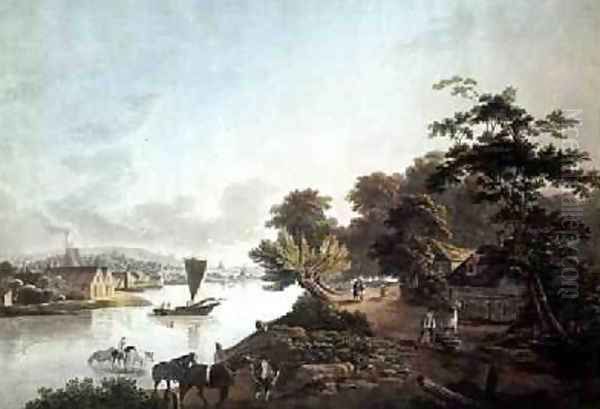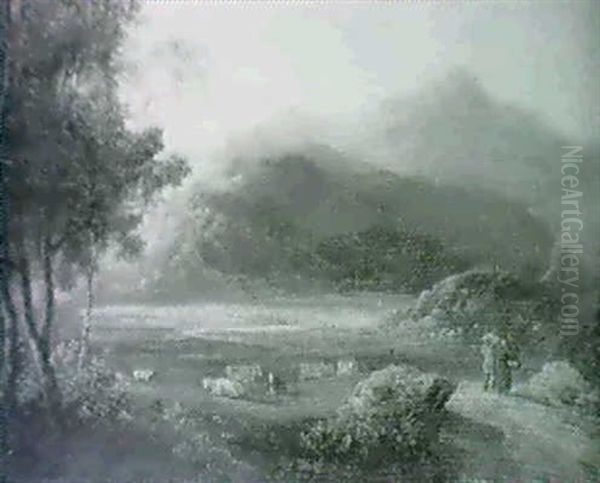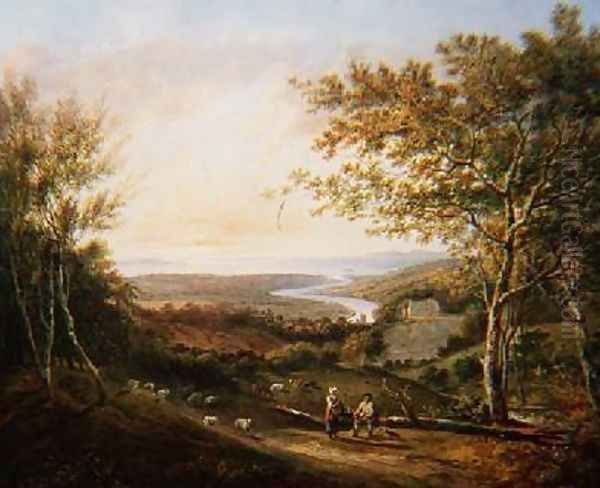John Laporte (1761–1839) stands as a significant, if sometimes overlooked, figure in the rich tapestry of British art during the late 18th and early 19th centuries. A prolific landscape painter, etcher, and influential drawing master, Laporte's career spanned a period of profound transformation in British art, witnessing the rise of Romanticism and the flourishing of watercolour painting as a respected medium. His contributions were manifold: as a creator of evocative landscapes, an innovator in printmaking techniques like soft-ground etching, a dedicated educator, and a publisher of instructional art manuals that guided a generation of aspiring artists.
Early Life and Artistic Formation
John Laporte was born in Dublin, Ireland, in 1761, to parents of French Huguenot extraction. This French heritage may have subtly influenced his artistic sensibilities, perhaps instilling an appreciation for clarity and structure that would later manifest in his didactic works. The family eventually relocated to London, the burgeoning epicentre of the British art world, which offered far greater opportunities for artistic training and patronage.
In London, Laporte's formal artistic education commenced under the tutelage of John Melchior Barralet (c. 1747–1815). Barralet, himself an Irish artist of French descent, was a versatile figure known for his landscapes, historical scenes, and book illustrations, working in both oil and watercolour. He had also spent time in Dublin before settling in London. Under Barralet, Laporte would have received a solid grounding in the principles of drawing, composition, and the handling of various media, particularly watercolour, which was gaining increasing favour among artists and collectors. Barralet's own style, often characterized by a picturesque sensibility, likely informed Laporte's early development.
Laporte proved to be a diligent student, quickly mastering the techniques of his craft. By 1785, he was confident enough to begin submitting his works to the prestigious Royal Academy of Arts in London. This marked the official commencement of his public career and his entry into the competitive London art scene. His regular appearance at the Royal Academy exhibitions over the subsequent decades would solidify his reputation.
A Flourishing Career: Exhibitions and Associations

Laporte's career gained momentum through consistent exhibition of his works. He was a frequent contributor not only to the Royal Academy but also to other significant institutions such as the British Institution and the Society of British Artists. Records indicate he exhibited an impressive 110 works at the Royal Academy, 102 at the British Institution (starting in 1821), and 18 at the Society of British Artists (starting in 1825). Such prolific output and visibility were crucial for an artist's success in this era.
A pivotal moment in his professional life was his association with the Society of Painters in Water Colours (often referred to as the "Old Watercolour Society"), of which he became a member. Founded in 1804 by artists like William Frederick Wells, Samuel Shelley, and William Sawrey Gilpin (nephew of the Picturesque theorist Reverend William Gilpin), the society aimed to elevate the status of watercolour painting, which was often seen as secondary to oil painting. Laporte's membership underscored his commitment to and proficiency in this medium. He exhibited alongside prominent watercolourists of the day, including John Varley, Cornelius Varley, Joshua Cristall, David Cox, and Peter De Wint, contributing to the "golden age" of English watercolour.
His landscapes, often depicting serene British scenery, found favour with the public. He travelled extensively throughout England, Wales, and the Lake District, capturing the diverse beauty of the British countryside. These sketching tours provided him with a rich repository of subjects for his finished watercolours and etchings. There is also evidence, through his depiction of Italianate scenes, that he may have travelled to Italy, or at least was deeply influenced by the classical landscapes popularised by artists like Claude Lorrain and Richard Wilson, and continued by his contemporaries.
Artistic Style and Technical Prowess
John Laporte's artistic style is primarily rooted in the British landscape tradition. His works often exude a sense of calm and order, reflecting the picturesque ideals prevalent in the late 18th century, which sought beauty in rustic scenery, gentle undulations of land, and carefully composed arrangements of natural elements. While not as dramatically sublime as some of his Romantic contemporaries like J.M.W. Turner or John Martin, Laporte's landscapes possess a quiet charm and a meticulous attention to detail, particularly in the rendering of foliage and atmospheric effects.

He was highly skilled in watercolour, employing both transparent washes and, at times, bodycolour (gouache) to achieve desired effects of light, texture, and depth. His handling of watercolour was often delicate yet assured, reflecting the growing sophistication of the medium during this period. His connection to the tradition of Paul Sandby (1731–1809), often called the "father of English watercolour," is evident in his topographical accuracy and his ability to capture the specific character of a place.
Beyond watercolour, Laporte was a master etcher, particularly adept in the technique of soft-ground etching. This method, which involved drawing with a pencil on a piece of paper laid over a soft, waxy etching ground, allowed for a softer, more granular line that could closely mimic the texture of chalk or pencil drawings. Laporte was an early adopter and a skilled practitioner of this technique, using it to great effect in his published works. This contrasted with the harder, more precise lines of traditional etching or engraving, offering a more painterly quality to the prints. His innovative use of this medium contributed to its popularity among artists seeking to reproduce the subtleties of their drawings.
His oil paintings, though perhaps less numerous than his watercolours, also demonstrate his skill. A notable example is Millbank on the River Thames, which adeptly combines a bucolic riverside scene with emerging industrial elements, capturing a moment of transition in the British landscape.
Landmark Publications: Educating the Masses
One of John Laporte's most enduring legacies lies in his instructional art manuals. He was a firm believer in systematising the process of learning to draw and paint, and his publications were designed to provide clear, step-by-step guidance for students and amateur artists.
His most celebrated work in this vein is Characters of Trees, published in parts between 1795 and 1801. This multi-volume series, often comprising six or seven books, was a comprehensive guide to drawing various species of trees. Each plate, typically a soft-ground etching, would illustrate the characteristic form, bark, and foliage of a specific tree – oak, elm, ash, poplar, and so on. Laporte understood that trees were fundamental elements of landscape painting, and his manual provided invaluable models for artists struggling to render them convincingly. The series was highly praised for its beauty and utility, described by some as possessing "unrivalled beauty" in the context of English landscape art instruction. It was often published by Laporte himself or through booksellers like Thomas Simpson or Thomas Macklin, a prominent publisher of the era.

Another significant publication was The Progress of a Water-Coloured Drawing, published around 1812. This work detailed his method for creating a watercolour painting, likely showing the stages from initial sketch to finished piece, demonstrating techniques for laying washes, building up tones, and adding details. It served as a practical guide, demystifying the process for many.
In 1805, he co-authored or contributed significantly to Process of Sketching a Landscape, with plates by himself and John P. Thompson, and published by T. Simpson. This manual, like his others, aimed to break down the complexities of landscape composition and execution into manageable steps, often featuring illustrations and etchings demonstrating various stages and techniques.
He also produced Sketch Book of Various Subjects from Nature, drawn and etched by himself, published in 1828. This later work continued his practice of providing models for study, showcasing a variety of natural forms and landscape elements. These publications not only disseminated his artistic knowledge but also significantly contributed to the popularisation of landscape drawing and watercolour painting among a wider audience.
Laporte as an Educator
Beyond his published works, John Laporte was an active and respected drawing master. For many years, he held the prestigious post of Drawing Master at the Addiscombe Military Seminary (also known as the East India Company Military Seminary) in Surrey. This institution trained cadets for service in the East India Company's private army. Topographical drawing and landscape sketching were considered important skills for military officers, useful for reconnaissance and recording terrain. Laporte's role there would have involved teaching practical drawing techniques to generations of young officers. His clear, methodical approach, evident in his books, would have been well-suited to this institutional setting.
He also taught private students. Among his most notable pupils was Dr. Thomas Monro (1759–1833). Dr. Monro, a physician and art patron, ran an informal "academy" at his homes in Adelphi Terrace and later Fetcham, Surrey. Here, he employed young, promising artists like J.M.W. Turner and Thomas Girtin to copy works from his collection, providing them with crucial early experience and patronage. That Laporte taught Dr. Monro himself speaks to his reputation as an instructor. This connection, however indirect, places Laporte within the orbit of some of the most revolutionary figures in British watercolour painting.
His teaching philosophy, as reflected in his manuals, emphasized careful observation of nature, a systematic approach to learning, and mastery of fundamental techniques. He provided a structured pathway for artistic development, which was invaluable in an era when formal art academies were not accessible to all.
Innovations in Printmaking: Lithography
Laporte was also among the early experimenters with the then-new technique of lithography in Britain. Invented by Alois Senefelder in Bavaria in the late 1790s, lithography allowed artists to draw directly onto a stone surface with a greasy crayon, offering a more autographic and painterly printmaking method than etching or engraving.
In 1807, Laporte's work Landscape with Deer under Tree was published in Specimens of Polyautography. "Polyautography" was one of the early English terms for lithography. This publication, featuring works by several artists including Benjamin West and Henry Fuseli, was a pioneering effort to showcase the potential of the new medium in Britain. Laporte's contribution demonstrates his willingness to explore new artistic technologies and his skill in adapting his landscape art to different media. His involvement places him at the forefront of printmaking innovation in the early 19th century.
Collaborations and Contemporaries
Throughout his career, John Laporte interacted and sometimes collaborated with a range of artists, publishers, and engravers. His teacher, John Melchior Barralet, was his first significant artistic connection. His publications involved collaborations with publishers like T. Simpson and engravers or artists like John P. Thompson.
His son, George Henry Laporte (c. 1799–1873), followed in his artistic footsteps, though he specialized primarily in animal painting, particularly horses, hunting scenes, and sporting subjects. George Henry became Animal Painter to the King of Hanover and was a prolific exhibitor, also contributing illustrations to publications like The Sporting Magazine. This familial artistic connection continued the Laporte name in the British art world.
As a member of the Society of Painters in Water Colours and a regular exhibitor, Laporte would have been well-acquainted with the leading figures of the London art scene. His contemporaries in landscape and watercolour included the aforementioned Turner, Girtin, John Varley, David Cox, Peter De Wint, as well as figures like Francis Nicholson, another influential drawing master, and John Constable, whose approach to landscape, while different, emerged from the same broader cultural appreciation for nature. He would have also been aware of the legacy of earlier landscape pioneers like Thomas Gainsborough and Richard Wilson, whose work laid the foundations for the British landscape school.
Anecdotes and Personal Life
While detailed personal anecdotes about John Laporte are somewhat scarce in historical records, certain aspects of his life offer glimpses into his character and circumstances. His French parentage, for instance, was a defining feature. The family's Huguenot background suggests a heritage of resilience and perhaps a certain independence of spirit.
There is a mention of his father, Bartholomew Laporte, being a key settler in French Azilum, Pennsylvania – a community established in the late 1790s as a potential refuge for French aristocrats fleeing the Revolution. If John Laporte spent any part of his childhood or had strong family ties there, it would add an interesting transatlantic dimension to his story, though his primary artistic development and career were firmly rooted in Britain. However, the more consistent accounts place his birth in Dublin and his upbringing and training in London.
His dedication to teaching, both at Addiscombe and through his widely circulated manuals, suggests a generous and methodical personality, keen on sharing his knowledge. The sheer volume of his output – paintings, etchings, and publications – points to a disciplined and industrious artist.
His involvement in animal and military painting, albeit less central than his landscapes, is noted. For instance, he is said to have produced illustrations for the King of Hanover depicting significant events at a horse race in 1839, the year of his death. This indicates a versatility that extended beyond pure landscape.
Art Historical Significance and Evaluation
John Laporte's significance in art history rests on several pillars. Firstly, he was a competent and prolific landscape artist in both watercolour and oil, contributing to the burgeoning British school of landscape painting. His works, while perhaps not reaching the sublime heights of Turner or the naturalistic intensity of Constable, possess a consistent quality and charm that appealed to the tastes of his time.
Secondly, his mastery and promotion of soft-ground etching were noteworthy. He skillfully used this technique to create prints that retained the freshness and texture of original drawings, making his instructional plates particularly effective. His early adoption of lithography also marks him as an artist open to innovation.
Thirdly, and perhaps most importantly, his role as an educator and author of instructional manuals had a profound and lasting impact. Works like Characters of Trees and The Progress of a Water-Coloured Drawing provided invaluable guidance to countless students and amateur artists, democratizing art education to some extent. These manuals helped to codify approaches to landscape drawing and watercolour painting, influencing artistic practice for decades. He helped to solidify a pedagogical tradition in British art.
Art historians today recognize Laporte as a key figure in the dissemination of artistic knowledge during a crucial period. While his own paintings are appreciated, his didactic works are seen as a major contribution to the development of amateur art practice and the professional training of artists in the 19th century. He successfully bridged the gap between artistic practice and art education.
Conclusion: An Enduring Influence
John Laporte passed away in London in 1839, leaving behind a substantial body of work and a significant educational legacy. He was an artist who understood the nuances of the British landscape, the technicalities of various artistic media, and the importance of clear instruction. Through his paintings, his innovative etchings, and his influential teaching manuals, Laporte carved out a distinct niche for himself in the annals of British art. He was a product of his time, reflecting the picturesque sensibilities and the growing enthusiasm for watercolour, but he was also a shaper of future artistic practice through his dedicated efforts as an educator and publisher. His work continues to be valued not only for its aesthetic merit but also for the crucial role it played in the artistic culture of 19th-century Britain.